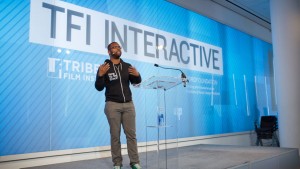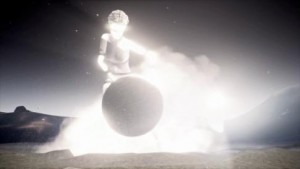 The TFI Interactive Day has been a highlight of Tribeca Film Festival’s innovaction curriculum. This year, the focus shifted from interactive documentaries to virtual reality, multimedia installations and create-a-thons.
The TFI Interactive Day has been a highlight of Tribeca Film Festival’s innovaction curriculum. This year, the focus shifted from interactive documentaries to virtual reality, multimedia installations and create-a-thons.
“I have been disappointed in the stagnation in the field,” Curator Opeyemi Olukemi said. “Interactive has weakened, while virtual reality has grown. We go to inspiring conferences, but then the creative energy weakens. So this year, we wanted to put people in the position of being makers, to mix it up, and encounter viewpoints that challenge them.
“Although the origin of Interactive Day was in documentary, that became a very narrow lens. As it has expanded, we saw stronger products emerge in virtual reality. But let’s be real–VR has also been overhyped. You have people rushing to market with headsets without the content. They’re not integrated with the interactive or storytelling communities.
“There needs to be a broader conversation. We need to revisit who’s at the table, be more inclusive, and tech companies have to be more flexible and be more collaborative and teamwork across the disciplines.”
The day featured a mix of activities, presentations and demonstrations. “We want you to leave feeling empowered to do more,” she said.
You could listen to Joanna Peña Bickley on immersive storytelling, and then group-brainstorm a story. You could hear Mike Kamber explain why he, a war photographer, started the Bronx Documentary Center and what a difference it makes to people to tell their own stories, and have Samuel Sinyangwe explain how social media changed organizing for #BlackLivesMatter. You could learn from Google’s VR filmmaker Jessica Brillhart about how to imagine editing in an immersive environment, and experiment with the makers of Notes on Blindness, the VR experience that lets viewers explore the world of a blind man.
 Among the exhibits, Forma allowed participants to join in an experience of group virtual reality. Across the Linegave you the (creepy) experience of being besieged by abortion-clinic protesters. Injustice gave you the chance to stick up for an African-American kid assaulted by police—or not. Makers were there to discuss challenges—there were many—of developing their prototypes and experiences.
Among the exhibits, Forma allowed participants to join in an experience of group virtual reality. Across the Linegave you the (creepy) experience of being besieged by abortion-clinic protesters. Injustice gave you the chance to stick up for an African-American kid assaulted by police—or not. Makers were there to discuss challenges—there were many—of developing their prototypes and experiences.
At Interactive Day, the future was in formation, and was participatory.
